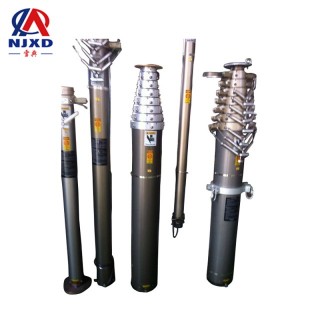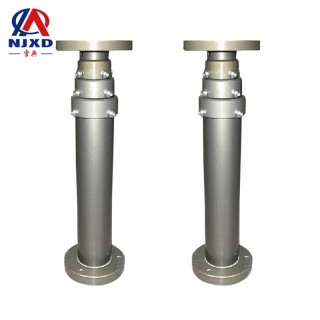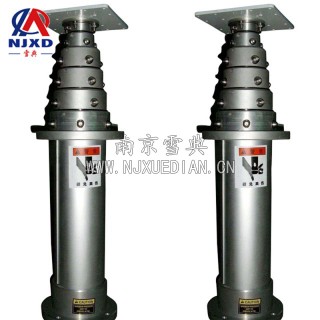NEWS
Pneumatic lifting rod multi-section cylinder structure and comparison with hydraulic type
Time:2020-10-20 View:

NJXD pneumatic lifting rod multi-section cylinder is composed of cylinder drum, end cap, piston, piston rod and sealing element.
1) cylinder drum
The inner diameter of pneumatic lifting rod multi-section cylinder barrel representative the output force of the cylinder. The piston should make smooth reciprocating sliding within cylinder drum, and the external surface roughness within cylinder drum should reach Ra0.8um. For steel pipe cylinder drum, the inner and outer surfaces should be electroplating hard chrome to reduce conflict resistance and abrasion and prevent corrosion. Cylinder drum raw material not only uses high-carbon steel pipe, but also uses high-strength aluminum alloy and brass. Small pneumatic lifting rod multi-section cylinders use stainless steel tube. Magnetic switch raw materials such as stainless steel aluminium alloy or brass should be used for cylinders with cylinder drum or used in corrosion-resistant environments.
SMC CM2 cylinder piston selects obturating ring assembly to complete bidirectional sealing, and the piston and piston rod are connected by riveting without nut. Pneumatic lifting rod professional suppliers in China, Nanjing Xuedian pneumatic mast factory direct sales three-year replacement.
2) end cover
The end cover of pneumatic lifting rod multi-section cylinder is equipped with inlet and exhaust ports, and the oil is also equipped with buffer tissue in the end cover. The rod side end cover is equipped with sealing ring and dust ring to prevent air leakage from piston rod and external dust from mixing into the cylinder. The rod side end cover is equipped with guide sleeve to improve the guiding precision of the cylinder, accept a small number of lateral loads on piston rod, reduce the bending amount when extending piston rod, and extend the service life of the cylinder. Guide sleeve generally, sintered oil-bearing alloy and forward copper castings are used. The end cover of pneumatic lifting rod multi-section cylinder used to be malleable cast iron. Now aluminium alloy order to reduce the weight and prevent rust, aluminum alloy die casting is often used, and brass information is used in miniature cylinders.
3) piston
Pneumatic lifting rod multi-section cylinder piston is the pressure-receiving parts in the cylinder. In order to prevent the left and right chambers of the piston from blowing air from each other, a piston obturating ring is provided. Wearproof ring on the piston can improve the orientation of the cylinder, reduce the abrasion of the piston obturating ring, and reduce the conflict resistance. Wearproof ring long use of polyurethane, PTFE, cloth clipping resin and other information. The width of the piston is determined by the size of the seal ring and the necessary length of the sliding part. The sliding part is too short, which may cause early wear and stuck. Raw material of piston is commonly aluminium alloy and cast iron, and small pneumatic lifting rod multi-section cylinder piston is made of brass. Pneumatic lifting rod professional suppliers in China, Nanjing Xuedian pneumatic mast factory direct sales three-year replacement.
4) piston rod
Pneumatic lifting rod multi-section cylinder piston rod is the most important force-bearing parts in the cylinder. Generally, high carbon steel is used, whose appearance is treated by electroplating hard chrome, or stainless steel is used to prevent corrosion and improve the wear resistance of obturating ring.
5) Obturating ring
The component seal at the reverse or reciprocating motion is called dynamic seal, and the seal of the stop part is called static seal.
The connection methods of multi-section pneumatic lifting rod of cylinder barrel and end cover mainly include the following:
Overall type. Riveting type, threaded connection type, flange type, bar type. Pneumatic lifting rod professional suppliers in China, Nanjing Xuedian pneumatic mast factory direct sales three-year replacement.

Performance Comparison with hydraulic lift rod
Pneumatic lifting rod:
Pneumatic lifting rod air compressor is installed in control cabinet, control cabinet can be placed in a suitable position on the ground, pneumatic lifting rod of the rod body only has pneumatic piston, no strong electricity, electric motor, moreover, the working voltage is safe 12V and 24V, therefore, it is very safe and reliable to use! PYF pneumatic lifting rod even if it is completely soaked in water for a long time, it can work normally, reliably and safely.
Hydraulic lift rod:
The hydraulic pump and motor are configured within lift rod, directly supplying power through 220V voltage! Because the hydraulic lift rod body is buried under the ground, there is the possibility of water inflow, which not only has a great impact on the safety and reliability of the product, but also has a great risk to pedestrians and maintenance personnel.
Pneumatic lifting rod:
The pneumatic system is clean and convenient to use and maintain, without any pollution to the environment. Pneumatic lifting rod due to the adoption of compressed air and quick connector, the installation personnel only need to make simple preparations to put into work, and the requirements for maintenance personnel are not high. There is no need to do cleaning work. At the same time, due to the use of hose, the exhaust pipe is very convenient! If the gas transmission pipe is damaged, the replacement is convenient and cheap.
Hydraulic lift rod:
Hydraulic lifting rod uses dirty hydraulic oil which may pollute the environment (hydraulic oil often leaks). Due to the complex structure of hydraulic system, the internal maintenance space is relatively small, and the technical requirements for installation and maintenance personnel are relatively high. The cleaning and maintenance work of the system is also required to be high, and the application environment is required to be high, and the maintenance work needs to be done frequently, otherwise, the operation speed may be reduced or the equipment operation may be difficult; At the same time, the oil supply copper tube is thick and hard, and the layout is very inconvenient!
Pneumatic lifting rod:
If the pneumatic system leaks air, the compressor will automatically pressurize, and the equipment can continue to work normally within a reasonable time. Moreover, pneumatic lifting rod air leakage has no cost, no pollution to the environment, and no maintenance costs.
Hydraulic lift rod:
For example, hydraulic system oil leakage, hydraulic pump failure and so on, the whole hydraulic system needs to be replaced, which is time-consuming, laborious and costly. Oil spill not only pollutes the environment, but also causes the system to fail to work normally.
Pneumatic lifting rod:
Part pneumatic lifting rod adopts the overall design, and part rod body can consider the anti-impact design more, so the anti-impact ability is strong, and the column after strengthening treatment has strong anti-impact ability, the equipment can still operate normally after the impact, which has a real anti-terrorism meaning. There is only a low-cost pneumatic piston within pneumatic lifting rod and Rod body. Even if it is accidentally hit, Rod body and the internal piston will be damaged. The maintenance cost is also very low and very simple. The rise and fall of pneumatic lifting rod are all driven by compressed air, which runs fast and can be used at high frequency.
Hydraulic lift rod:
Plastic carriage is used, which means it has almost no impact resistance. A little collision requires repair, and the maintenance cost is very high! At the same time, lift rod is directly fixed on the hydraulic cylinder central shaft without any damping measures. In case of collision, the hydraulic cylinder is easy to be destroyed, oil spill, which leads to the decrease of equipment running speed or failure to operate. Hydraulic cylinder has high requirements and needs special customization, which is of high cost. When Rod body is accidentally hit, the hydraulic electric motor integrated within rod body is easily damaged, and the maintenance is time-consuming and costly.

CATEGORY
NEWS
- Selection of vehicle-mounted lift rod and winter protection and unfreezing
- Pneumatic lifting rod multi-section cylinder structure and comparison with hydraulic type
- Pneumatic lifting rod cylinder classification and obturating ring type
- Brief Analysis of working principle and technical comparison of pneumatic lifting platform
- Special Vehicle-mounted air compressor emergency communication vehicle for pneumatic lifting rod